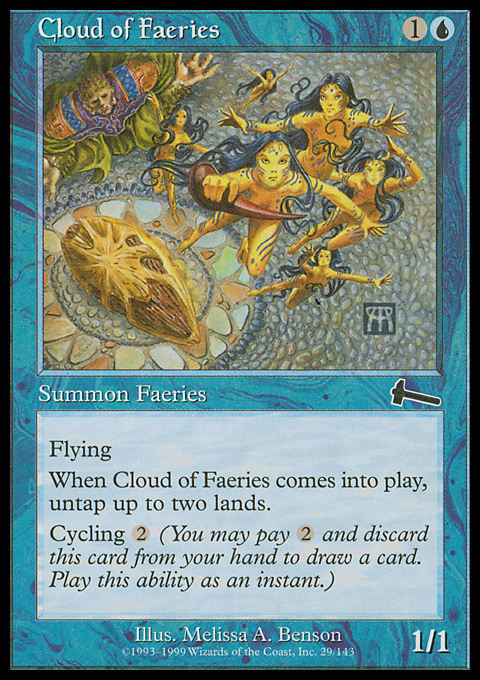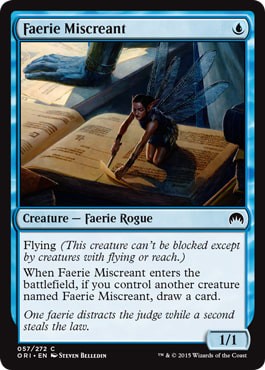Pauper Delver is not dead. Cloud of Faeries may be banned, but their blue brethren will carry on.
The easiest conversion of Mono-Blue Delver is to substitute the four banned Faeries with four new ones. Faerie Miscreant is the clear frontrunner for this appointment.
Post-Ban Mono-Blue Delver ? Pauper | John Rohan
- Creatures (19)
- 4 Delver of Secrets
- 4 Faerie Miscreant
- 4 Ninja of the Deep Hours
- 4 Spellstutter Sprite
- 3 Spire Golem
- Spells (24)
- 1 Mana Leak
- 1 Oona's Grace
- 1 Piracy Charm
- 2 Daze
- 2 Gush
- 4 Counterspell
- 4 Snap
- 4 Ponder
- 4 Preordain
- 1 Bonesplitter
- Lands (17)
- 17 Island
Out with the Old
Free spells are good spells, and Cloud of Faeries was a very good spell. The interaction between Spellstutter Sprite and Cloud of Faeries formed the core synergy of the Delver decks. All of the other cards in the traditional versions of the Delver deck work perfectly with the two Faerie cards.
This combination of cards could easily put the Delver deck ahead and keep it ahead. The dreaded turn-one Delver of Secrets into a turn-two Cloud of Faeries representing Spellstutter Sprite was a blue mage's dream. This gave the Delver deck 5 points of flying damage on turn three.
Countering an opposing aggressive player’s 2-drop with this combo was backbreaking. Not only would the aggressive player be left with nothing to show for his or her turn-two play, but he or she was presented with an additional 2 points of damage a turn.
The combination of these cards bullied aggressive decks centered on 2-drops out of the metagame. The only way to ensure your turn-two play would resolve was to play two 1-drops. Goblins and Stompy developed around this principal.
Ninja of the Deep Hours also benefited from Cloud of Faeries. With 4 mana available, Cloud of Faeries could ninjutsu the Ninja into play and be replayed to fuel and represent a Spellstutter Sprite or Counterspell. Returning Spellstutter Sprite with a Ninja is more impressive with another Faerie in play.
Cloud of Faeries could wear a Bonesplitter with the best of them, and to top it all off, in the situation in which none of the above was relevant, you could even cycle Cloud of Faeries away!
Geeze, what a card.
In With the New
Faerie Miscreant has some big shoes to fill.
Faerie Miscreant still fuels Spellstutter Sprite, but it comes with an opportunity cost. The days of countering your opponents turn-two play and shoving 5 points of flying power into the red zone are over. Delver players now must decide between their old turn-one plays of Delver of Secrets or Preordain and setting up a Faerie Miscreant–fueled turn-two Spellstutter Sprite. This is Faerie Miscreant’s greatest weakness.
Delver players will want to play Faerie Miscreant as early as possible to give Spellstutter Sprite the highest chance of impacting the game. This will lead to more turn-two sequences of a cantrip into a Faerie Miscreant. Turn two should be a turn for Delver's opponents to resolve a meaningful spell.
The good news for Delver players is Faerie Miscreant might be better at setting up Ninja of the Deep Hours than its predecessor. With Faerie Miscreant, Ninja of the Deep Hours can more reliably hit the table on turn two. On the following turn, players will have to decide between replaying the Miscreant and casting a cantrip—a small price to play for landing an early Ninja of the Deep Hours. With 3 mana available, Faerie Miscreant can be played after enabling ninjutsu. These are plays that Cloud of Faeries could not facilitate.
Returning Cloud of Faeries with the Ninja is more mana-efficient than returning Faerie Miscreant on or after turn four. This is not that big of a drawback because the Delver player would rather rebuy a Spellstutter Sprite trigger during this stage of the game. Also, getting an attack in with Ninja of the Deep Hours brings the Delver player one card closer to a second Miscreant. That’s not to mention that ninjutsu’ing one of two Faerie Miscreants rivals the value generated by Mulldrifter.
Faerie Miscreant can also bring the beats by picking up a Bonesplitter and attacking on turn two. This is not going to be the optimal play a majority of the time, but it is something to be aware of.
The ability to draw a card off additional Faerie Miscreants is where the power of this card lies, but this power comes with a very high setup cost. Knowing when to protect a Faerie Miscreant will be an important skill for Delver players to acquire.
1 Mana Is a Lot More Mana
Delver decks who adopt Faerie Miscreant are going to be slightly more constrained on mana than the Cloud of Faeries builds were.
1-Mana Faerie creates conflict in spots where a free Faerie would not. This comes at the cost of not finding the spot for a Preordain. Keeping up two pieces of permission could carry the opportunity cost of not casting a Faerie Miscreant in the midgame. Delver players will have to make decisions based on meaningful opportunity costs.
Spellstutter Sprite is less effective without Cloud of Faeries. An opening hand with Ponder and Spellstutter Sprite on the play could allow for an empowered Sprite trigger on turn two if Cloud of Faeries was drawn off the Ponder. Now, this same hand cannot allow for a turn-two, empowered Spellstutter Sprite trigger. So, some percentage of the time, the Delver player will have to decide if it is better to run out a Miscreant and a cantrip on turn two or hold up a Spellstutter Sprite for one.
It is in these scenarios, Snap also loses some power but gains a touch more utility. It will be harder to return Spellstutter Sprite to counter a meaningful spell with the additional cost of empowering the triggered ability. However, Snapping one of two Faerie Miscreants allows Snap to cycle.
The higher mana and opportunity cost associated with setting up Spellstutter Sprite will put a lot of pressure on the deck’s early counterspells. Counterspell might need a non-Deprive counterpart to plug the turn-two hole created in traditional builds adopting Faerie Miscreant. Deprive further constrains the deck’s early mana development and costs 2 mana. Deprive does shine in the late game, when any of its replacements would be weaker. Since it will be harder to find spots to cast Preordain and Ponder, I would be surprised if Logic Knot would be a viable choice. Daze is my initial pick for the turn-two counterspell.
I do not believe that Daze or Gush is negatively affected by the same mana-development concerns that affect Deprive. The difference between 0 and 2 mana is a lot in this new build. Daze should see a surge in popularity (if not gated by availability) because it is a way to counter a 2-drop on turn two after casting a Faerie Miscreant and a cantrip. If anything, I think Daze will benefit from the banning of Cloud of Faeries. By the time Gush is a viable play, the Delver player should be able to alleviate some of the mana pressures presented by the 1-mana Faerie. Drawing more cards means increasing the ability to draw multiple Faerie Miscreants.
Other Directions
One way to alleviate the opportunity cost of playing Faerie Miscreant is to back it up with more 1-mana spells. Additional 1-mana creatures can really help Miscreant function without impacting the development turns. If the deck is designed to play two 1-mana spells on turn two, rather than keep up countermagic, Faerie Miscreant becomes better.
Delver Bear ? Pauper | John Rohan
- Creatures (22)
- 2 Frostburn Weird
- 4 Delver of Secrets
- 4 Faerie Miscreant
- 4 Ninja of the Deep Hours
- 4 Phantasmal Bear
- 4 Spellstutter Sprite
- Spells (22)
- 2 Daze
- 2 Mutagenic Growth
- 2 Vapor Snag
- 4 Counterspell
- 4 Snap
- 4 Ponder
- 4 Preordain
- Lands (16)
- 16 Island
This build embraces the aggressive side of Delver. Delver Bear could make a comeback in an attempt to make the deck more mana-efficient while impacting the board. Vapor Snag and Snap can handle any problematic creatures that fell through the cracks in the early turns. Countermagic will keep the opponent off balance long enough for the aggressive creatures to put away the game.
Magic Online player Tedlyted was already playing Faerie Miscreant alongside Cloud of Faeries in a Blue Zoo deck. Below is a potential adaptation of the deck for after the bans:
Blue Zoo ? Pauper | John Rohan
- Creatures (33)
- 3 Dream Stalker
- 3 Fathom Seer
- 3 Stormbound Geist
- 4 Cloudfin Raptor
- 4 Faerie Miscreant
- 4 Ninja of the Deep Hours
- 4 Phantasmal Bear
- 4 Spellstutter Sprite
- 4 Spire Golem
- Spells (9)
- 2 Daze
- 2 Mutagenic Growth
- 1 Gitaxian Probe
- 4 Preordain
- Lands (18)
- 18 Island
Trading in four Cloud of Faeries for an additional Daze and three Phantasmal Bears gives the deck some more aggression while providing additional protecting for an early Cloudfin Raptor. Unfortunately, losing Cloud of Faeries takes away Dream Stalker’s free target. The addition of Phantasmal Bear makes up for this loss by allowing the deck to still evolve Cloudfin Raptor into a 2/3 creature on turn two. Daze and Spellstutter Sprite are the deck’s only sources of countermagic, and that is right in Faerie Miscreant’s wheelhouse. Faerie Miscreant is right at home with this group of creatures.
If the deck wants a cute way to up the Faerie count, Faerie Squadron might be worth a look. If there is any deck that would want to play this card, it is a deck with Spellstutter Sprite and seven ways to pick up the Squadron for value.
Assuming a more controlling posture is another way to lessen Faerie Miscreant’s mana burden. The longer a game goes, the more opportunities the control deck has to regain the forfeited tempo. Also, controlling builds could afford to hold off on Miscreant to find better opportunities later in the game. It could even dip into other colors for more board-impacting spells. Faerie Miscreant also helps lower the burden of enters-the-battlefield-tapped dual lands. Tedlyted gives us another deck that proves you do not need Cloud of Faeries to win a Pauper league:
Pauper Control ? Pauper | Tedlyted
- Creatures (19)
- 3 Ninja of the Deep Hours
- 4 Faerie Miscreant
- 4 Mulldrifter
- 4 Sea Gate Oracle
- 4 Spellstutter Sprite
- Spells (20)
- 2 Dispel
- 2 Remove Soul
- 4 Counterspell
- 4 Lightning Bolt
- 4 Flame Slash
- 4 Preordain
- Lands (21)
- 1 Mountain
- 10 Island
- 2 Izzet Boilerworks
- 4 Izzet Guildgate
- 4 Swiftwater Cliffs
This main deck went undefeated in a world where Cloud of Faeries existed. This deck uses Faerie Miscreant to fill the holes of a 2-mana Pauper mana base. Preordain is the go-to Pauper control cantrip. Faerie Miscreant and Preordain are proactive cards that can be played on turn one or turn two with a tapped land. Lightning Bolt and Flame Slash can remove creatures that slip by in the early turns. Remove Soul is much better than Mana Leak in a deck that is not preoccupied with protecting Delver of Secrets. Remove Soul ensures that any creature cast into 2 available mana will be dealt with.
Maybe the best way to avoid the awkwardness of Faerie Miscreant is to just ignore its existence entirely. Mo’ Faeries, mo’ problems—am I right?
Mono-Blue Control ? Pauper | John Rohan
- Creatures (10)
- 2 Mulldrifter
- 4 Delver of Secrets
- 4 Spire Golem
- Spells (27)
- 1 Gush
- 1 Oona's Grace
- 3 Deprive
- 3 Exclude
- 3 Prohibit
- 4 Counterspell
- 4 Repeal
- 4 Think Twice
- 4 Preordain
This is a rough outline of a Mono-Blue Control deck that is not concerned with Faerie synergy. This deck plans on trading cards on a one-for-one basis and then reloading with card-advantage spells. Repeal is great at generating value while bouncing troublesome permanents that slipped though permission. It is important to note that this deck is very cold to Kiln Fiend. Additional Quicksands should help deal with that little devil.
Takeaway
The traditional builds of Delver are still viable, but they are burdened by slightly more cumbersome mana and higher opportunity costs to set up their best tempo plays.
Delver was once an oppressive deck with few exploitable flaws; now the deck will give its opponents opportunities to resolve impactful spells on the second turn of the game a greater percentage of the time.
Delver players will need to be more precise in the developing turns of the game and gauge the importance of setting up an empowered Sprite trigger against the value of casting an early Delver of Secrets or cantrip. These are decisions that the Delver player did not have to make when it had access to Cloud of Faeries.
I always thought I knew how good Cloud of Faeries was, but after writing about the state of the Delver deck, I have a newfound appreciation for just how degenerate that card was.
When building decks for the post-ban Pauper format, keep in mind that Delver is still a viable deck. Spellstutter Sprite and fiends are coming for your spells and your life points. Know that you will have a greater opportunity to resolve important spells on the second turn of the game.
Delver players, I hope this article has helped you grieve. Keep the faith, and know there is life beyond the clouds.
—John Rohan
Uhen on Magic Online
@John_Uhen on Twitter




























